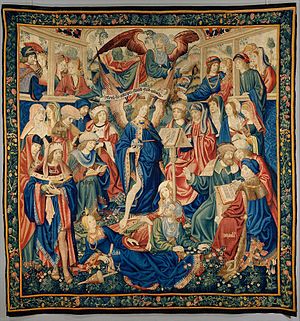
The unicorn is a legendary creature that has been described since antiquity as a beast with a single large, pointed, spiraling horn projecting from its forehead.

François Boucher was a French painter, draughtsman and etcher, who worked in the Rococo style. Boucher is known for his idyllic and voluptuous paintings on classical themes, decorative allegories, and pastoral scenes. He was perhaps the most celebrated painter and decorative artist of the 18th century.

Tapestry is a form of textile art, traditionally woven by hand on a loom. Tapestry is weft-faced weaving, in which all the warp threads are hidden in the completed work, unlike most woven textiles, where both the warp and the weft threads may be visible. In tapestry weaving, weft yarns are typically discontinuous ; the artisan interlaces each coloured weft back and forth in its own small pattern area. It is a plain weft-faced weave having weft threads of different colours worked over portions of the warp to form the design.

The Cloisters, also known as the Met Cloisters, is a museum in the Washington Heights neighborhood of Upper Manhattan, New York City. The museum, situated in Fort Tryon Park, specializes in European medieval art and architecture, with a focus on the Romanesque and Gothic periods. Governed by the Metropolitan Museum of Art, it contains a large collection of medieval artworks shown in the architectural settings of French monasteries and abbeys. Its buildings are centered around four cloisters—the Cuxa, Saint-Guilhem, Bonnefont and Trie—that were acquired by American sculptor and art dealer George Grey Barnard in France before 1913, and moved to New York. Barnard's collection was bought for the museum by financier and philanthropist John D. Rockefeller, Jr. Other major sources of objects were the collections of J. P. Morgan and Joseph Brummer.

The Raphael Cartoons are seven large cartoons for tapestries, surviving from a set of ten cartoons, designed by the High Renaissance painter Raphael in 1515-16, commissioned by Pope Leo X for the Sistine Chapel in the Vatican Palace. The tapestries show scenes from the Gospels and Acts of the Apostles and are hung below the frescoes of the Life of Christ and the Life of Moss commissioned by Pope Sextus. The cartoons belong to the British Royal Collection but since 1865 are on loan to the Victoria and Albert Museum in London.

The Hunt of the Unicorn or the Unicorn Tapestries is a series of seven tapestries made in the South Netherlands around 1495–1505, and now in The Cloisters in New York. They were possibly designed in Paris and show a group of noblemen and hunters in pursuit of a unicorn through an idealised French landscape. The tapestries were woven in wool, metallic threads, and silk. The vibrant colours, still evident today, were produced from dye plants: weld (yellow), madder (red), and woad (blue).

Jacopo Caraglio, Giovanni Jacopo Caraglio or Gian Giacomo Caraglio known also as Jacobus Parmensis and Jacobus Veronensis was an Italian engraver, goldsmith and medallist, born at Verona or Parma. His career falls easily into two rather different halves: he worked in Rome from 1526 or earlier as an engraver in collaboration with leading artists, and then in Venice, before moving to spend the rest of his life as a court goldsmith in Poland, where he died.
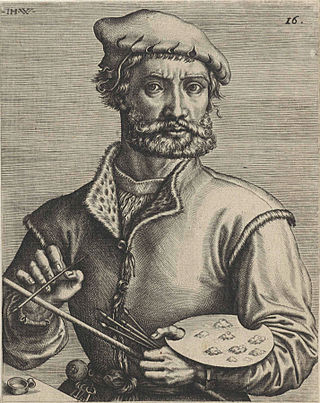
Pieter Coecke van Aelst or Pieter Coecke van Aelst the Elder was a Flemish painter, sculptor, architect, author and designer of woodcuts, goldsmith's work, stained glass and tapestries. His principal subjects were Christian religious themes. He worked in Antwerp and Brussels and was appointed court painter to Charles V, Holy Roman Emperor.
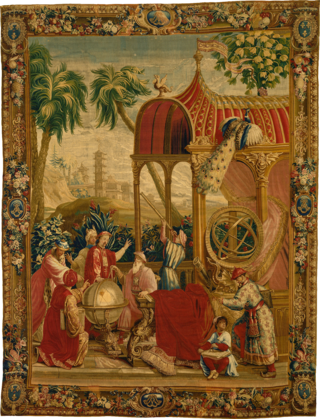
The Beauvais Manufactory is a historic tapestry factory in Beauvais, France. It was the second in importance, after the Gobelins Manufactory, of French tapestry workshops that were established under the general direction of Jean-Baptiste Colbert, the finance minister of Louis XIV. Whereas the royal Gobelins Manufactory executed tapestries for the royal residences and as ambassadorial gifts, the manufacture at Beauvais remained a private enterprise. Beauvais specialised in low-warp tapestry weaving, although the letters patent of 1664, authorising the company and offering royal protection, left the field open for the production of high-warp tapestry as well.

The Valois Tapestries are a series of eight large tapestries depicting festivities or "magnificences" held by Catherine de' Medici's Royal Courts in the second half of the 16th century. The tapestries were primarily modeled on drawings by Antoine Caron, but to Caron's distant views of large panoramas crowded with figures much larger portraits of leading persons at the French court have been added in the foreground, usually to the side, as well as elaborate borders.

Samite was a luxurious and heavy silk fabric worn in the Middle Ages, of a twill-type weave, often including gold or silver thread. The word was derived from Old French samit, from medieval Latin samitum, examitum deriving from the Byzantine Greek ἑξάμιτον hexamiton "six threads", usually interpreted as indicating the use of six yarns in the warp. Samite is still used in ecclesiastical robes, vestments, ornamental fabrics, and interior decoration.

Brussels tapestry workshops produced tapestry from at least the 15th century, but the city's early production in the Late Gothic International style was eclipsed by the more prominent tapestry-weaving workshops based in Arras and Tournai. In 1477 Brussels, capital of the duchy of Brabant, was inherited by the house of Habsburg; and in the same year Arras, the prominent center of tapestry-weaving in the Low Countries, was sacked and its tapestry manufacture never recovered, and Tournai and Brussels seem to have increased in importance.

The Apocalypse Tapestry is a large medieval set of tapestries commissioned by Louis I, the Duke of Anjou, and woven in Paris between 1377 and 1382. It depicts the story of the Apocalypse from the Book of Revelation by Saint John the Divine in colourful images, spread over six tapestries that originally totalled 90 scenes, and were about six metres high, and 140 metres long in total.
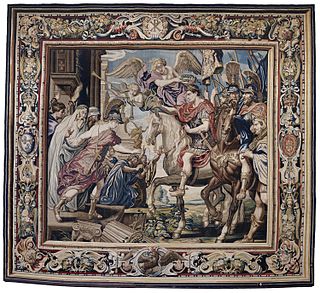
The History of Constantine is a series of tapestries designed by Flemish artist Peter Paul Rubens and Italian artist Pietro da Cortona depicting the life of Constantine I, the first Christian emperor of Ancient Rome. In 1622, Rubens painted the first twelve oil sketches that were used as guides, and the tapestries themselves were woven in the workshop of Marc Comans and François de la Planche in the Faubourg Saint-Marcel in Paris by 1625, transforming each small sketch into a sumptuous creation of wool, silk, and gold and silver threads that could easily fill a wall. An additional five designs were painted by Cortona in 1630 and woven in the atelier of Cardinal Francesco Barberini in Rome over the next decade.
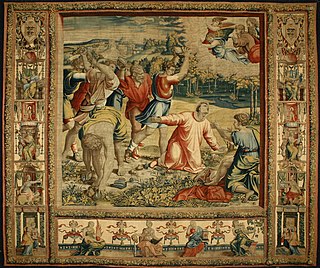
Pieter van Aelst or Pieter van Aelst III was a Flemish tapestry weaver whose workshop commenced by his grandfather was one of the leading weavers of Flanders in the first half of the 16th century.

The Franses Tapestry Archive and Library in London is devoted to the study of European tapestries and figurative textiles. It is the world’s largest academic research resource on the subject.

The Diptych of Federico da Montefeltro and Battista Sforza are two oil paintings by Italian artist Piero della Francesca, dated to 1473–1475. This famed double portrait is often mistitled The Duke and Duchess of Urbino—as it appears on the website of the Uffizi Gallery, which owns it. Since Battista Sforza died in 1472 and Federico da Montefeltro was not made duke until 1474, however, Battista never attained the title of duchess.

Patio from the Castle of Vélez Blanco is a 1510s marble patio; an example of Spanish Renaissance architecture. It is in the collection of the Metropolitan Museum of Art. It was originally part of the Castillo de Vélez-Blanco in Vélez-Blanco, Andalusia, Spain. The patio now serves as the entrance of the museum's Thomas J. Watson Library and to showcase the museum's Italian Renaissance statues.

Triumphs is a 14th-century Italian series of poems, written by Petrarch in the Tuscan language. The poem evokes the Roman ceremony of triumph, where victorious generals and their armies were led in procession by the captives and spoils they had taken in war. This was a popular and influential poem series when it was published.

The Hunts of Maximilian or Les Chasses de Maximilien, also Les Belles chasses de Guise are a set of twelve tapestries, one per month, depicting hunting scenes in the Sonian Forest, south of Brussels, by the court of Maximilian I, Holy Roman Emperor. They were produced in a Brussels workshop, and several tapestries are given identifiable locations that were then around the outskirts of the city, but are now mostly engulfed by it. The set is now in the Louvre.
